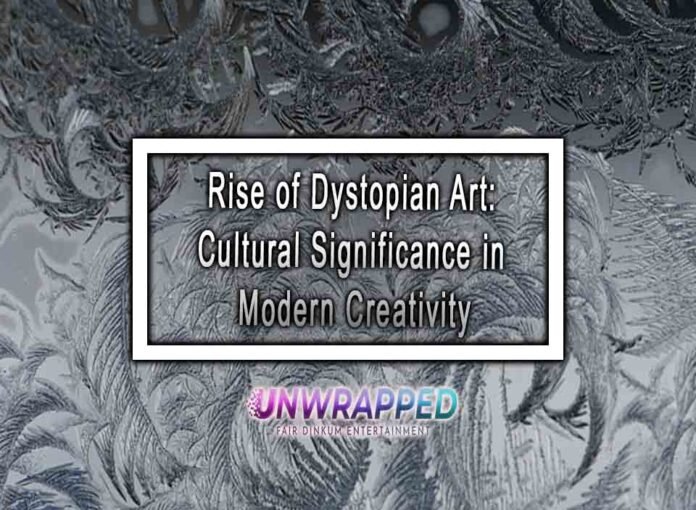Dystopian themes have become a defining feature of modern art, reflecting the anxieties, challenges, and complexities of contemporary society. As the world faces environmental crises, political turmoil, and technological advancements, artists have turned to dystopian imagery to critique, question, and inspire. Through vivid visuals and profound narratives, dystopian art transcends its medium, offering a cultural lens into our collective fears and aspirations.
This article explores the cultural significance of dystopian themes in modern art, examining how they shape societal discourse, challenge traditional norms, and spark global conversations. From their historical roots to their evolving role in the digital age, we delve into the reasons why dystopia continues to captivate artists and audiences alike.
The Historical Roots of Dystopian Art
Early Inspirations
- Literature and Philosophy:
- Dystopian themes in art draw inspiration from classic works like George Orwell’s 1984 and Aldous Huxley’s Brave New World.
- Philosophical discussions on societal control, freedom, and human nature influenced early dystopian artists.
- Industrial Revolution:
- The rise of industrialization brought fears of dehumanization and environmental degradation, inspiring dystopian depictions in 19th-century art and literature.
Transition to Modern Art
- The 20th century, marked by wars and technological upheaval, gave rise to dystopian artistic movements, such as surrealism and futurism.
- Artists like Salvador Dalí and Otto Dix used dystopian imagery to critique war, politics, and societal decay.
Dystopian Art as a Reflection of Society
Addressing Societal Fears
- Environmental Concerns:
- Dystopian art often highlights the consequences of climate change, pollution, and ecological collapse.
- Example: Olafur Eliasson’s installations, like Ice Watch, draw attention to melting glaciers and global warming.
- Technological Dependency:
- Artists critique the overreliance on technology, surveillance, and artificial intelligence.
- Works like Trevor Paglen’s Surveillance Landscapes reveal the hidden mechanisms of data monitoring.
- Political Oppression:
- Many dystopian pieces explore themes of authoritarianism, censorship, and human rights violations.
- Shepard Fairey’s Obey Giant campaign is a powerful commentary on control and propaganda.
A Mirror to Cultural Shifts
- Dystopian art captures societal shifts, serving as both a warning and a reflection of humanity’s trajectory.
- It challenges viewers to confront uncomfortable truths and question societal norms.
The Aesthetic Elements of Dystopian Art
Visual Characteristics
- Dark and Foreboding Color Palettes:
- Grays, blacks, and muted tones evoke a sense of despair and forewarning.
- Futuristic Imagery:
- Depictions of decaying cities, robotic entities, and dystopian technology highlight a stark vision of the future.
- Juxtaposition:
- Contrasts between beauty and decay, nature and machinery, or freedom and oppression emphasize tension.
Symbolism in Dystopian Art
- Cages and Barriers: Represent lack of freedom or societal constraints.
- Eyes and Surveillance: Symbolize control and the loss of privacy.
- Ruins and Wastelands: Reflect societal collapse and environmental destruction.
Dystopian Themes in Different Mediums
Painting and Illustration
- Artists like Zdzisław Beksiński create hauntingly surreal worlds, blending elements of decay and dystopia.
- Contemporary painters use mixed media to incorporate found objects, digital elements, and text into their works.
Film and Digital Media
- Films like Blade Runner and The Matrix influence visual artists, shaping dystopian aesthetics.
- Digital artists leverage 3D modeling and augmented reality to immerse audiences in dystopian environments.
Street Art and Public Installations
- Street art frequently addresses dystopian themes, serving as a form of activism and public engagement.
- Examples include murals protesting climate inaction or installations like Ai Weiwei’s Good Fences Make Good Neighbors.
Dystopian Art as Cultural Critique
Political Commentary
- Dystopian art often critiques authoritarian regimes, inequality, and social injustice.
- Artists challenge power structures and inspire activism through provocative visuals.
Environmental Advocacy
- With the climate crisis looming, dystopian art amplifies calls for sustainability and environmental awareness.
- Works like Agnes Denes’s Wheatfield – A Confrontation juxtapose urban development with ecological concerns.
Exploring Human Psychology
- Dystopian art delves into existential questions about humanity, morality, and resilience.
- Themes of isolation, fear, and survival resonate deeply with modern audiences.
The Role of Technology in Dystopian Art
Creation and Dissemination
- Digital Tools:
- Tools like Photoshop, Blender, and AI programs allow for the creation of hyper-realistic dystopian visuals.
- Social Media Platforms:
- Instagram and Pinterest help artists share dystopian works with a global audience, sparking dialogue.
Critiquing Technology’s Role in Society
- While technology empowers artists, it also becomes a subject of critique in dystopian themes.
- Digital surveillance, data privacy, and AI ethics are recurring motifs in dystopian art.
Why Dystopian Themes Resonate with Audiences
- Universal Fears:
- Themes of loss, oppression, and survival are universally relatable, transcending cultural boundaries.
- Call to Action:
- Dystopian art inspires viewers to reflect on societal issues and take action for change.
- Emotional Connection:
- The stark imagery and thought-provoking narratives evoke powerful emotional responses, fostering empathy and introspection.
Challenges and Criticism of Dystopian Art
- Over-Saturation:
- The prevalence of dystopian themes in media can lead to desensitization or fatigue among audiences.
- Commercialization:
- As dystopian aesthetics gain popularity, some argue they risk becoming commodified and losing their critical edge.
- Balancing Hope and Despair:
- Critics argue that dystopian art should also provide hope or solutions, rather than solely focusing on despair.
Conclusion
Dystopian themes in modern art serve as a powerful cultural lens, reflecting the fears, challenges, and aspirations of contemporary society. By addressing critical issues like environmental degradation, political oppression, and technological dependency, dystopian art not only critiques but also inspires action and awareness.
As we navigate an uncertain future, dystopian art challenges us to confront our reality, question societal norms, and envision alternative possibilities. It is a testament to art’s enduring role in shaping culture, provoking thought, and fostering resilience in the face of adversity.
See Also: Street Art and Urban Psychology: How Public Art Shapes Communities










